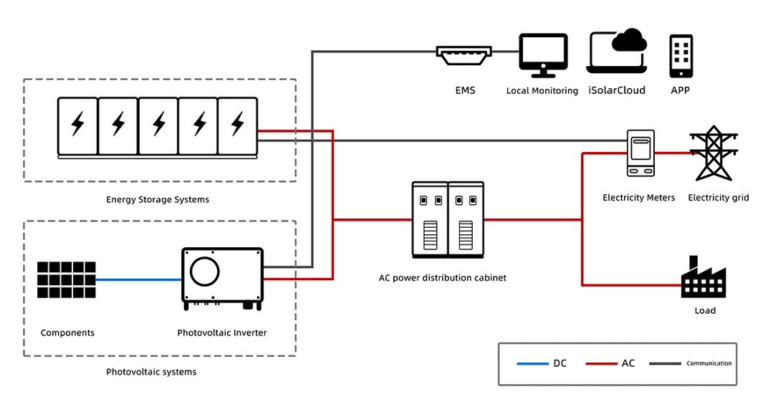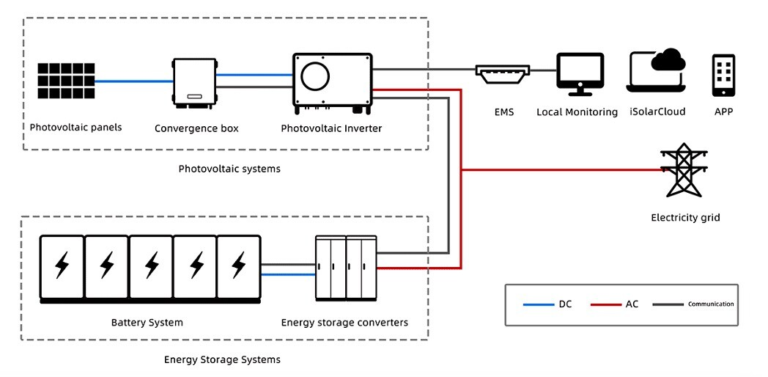Battery Energy Storage Systems (BESS) and its benefits
Battery energy storage systems (BESS) are rapidly gaining popularity due to technological advancements, cost reductions, and increased awareness of their benefits. Over the next five years, BESS adoption is expected to accelerate, driven by policies promoting renewable energy integration and grid stability. Key factors such as government incentives, technological innovations, and the growing demand for renewable energy storage, electric vehicle charging, household energy solutions, and backup power systems will significantly boost the uptake of BESS.
Comercial and Industrial (C&I) BESS
C&I energy storage is mainly applied to the self-supply power of commercial and industrial users which includes factories, buildings, data centers, etc. The purpose is to reduce peak-valley electricity tariff for users and improve the reliability of power supply.
The capacity of C&I energy storage is generally in the range of several tens to hundreds of kilowatt-hours, mainly depending on the user’s load size and tariff demand. The capacity of ultra-large-scale C&I systems generally does not exceed 10,000 kWh.

Utility BESS
Utility-scale energy storage is mainly applied to the grid side. The purpose is to balance power supply and demand, regulate grid frequency, and achieve peak-valley regulation. It can also provide spare capacity and other power regulation services.
The capacity of utility-scale energy storage ranges from several megawatt-hours to several hundred megawatt-hours, matching the grid scale and demands. For some large grid-level projects, the capacity of a single site can reach hundreds of megawatt-hours.

Benefits and challenges for BESS
Benefits
- Enabling higher renewable energy penetration: BESS allow excess renewable energy to be stored when generation exceeds demand, and discharged when demand exceeds renewable generation. This helps integrate more variable renewable sources like wind and solar into the grid.
- Grid balancing and ancillary services: BESS can quickly inject or absorb power to help balance the grid and provide services like frequency regulation. Their fast response times make them well-suited for this.
- Peak shaving and energy arbitrage: By charging during low demand periods and discharging during peak periods, BESS can reduce strain on the grid during peaks and enable energy arbitrage by buying low and selling high.
- Backup power and increased resilience: BESS can provide backup power during outages for increased grid resilience and reliability for critical infrastructure.
Challenges
- High upfront costs: While declining, the upfront capital costs of BESS remain relatively high compared to other storage options. This is a barrier to more widespread deployment.
- Limited energy density and cycle life: Current battery technologies have limited energy densities and cycle lives compared to the theoretical maximums, reducing their effective storage capacities over time.
- Materials supply chain risks: Key battery materials like lithium have constrained and geographically concentrated supply chains, posing potential risks.
- Safety concerns: Thermal runaway is a risk with battery chemistries like lithium-ion, requiring robust safety systems. This adds complexity and cost.
- Lack of standardisation: With many competing battery technologies, there is a lack of technical standardisation that can complicate deployment and integration.
Solarity’s portfolio of BESS products
DEYE Hybrid 50kW HV + HV Battery BOS-G
Deye Hybrid 50kW HV is a brand new series of three phase hybrid inverter supporting 160-700V HV Battery combined with the Deye BOS-G series is a state-of-the-art LiFePO4 battery system designed to provide reliable, safe, and efficient energy storage for your home or business.
Key Features
- 800V battery for higher efficiency
- charging/discharging current of 100A
- 36A * 4 MPPTs = more energy production
- 10 pcs parallel & Support multiple batteries parallel
- 6 time periods for battery charging/discharging
- UPS Level Grid-to-Off-Grid Switching
- Support Diesel Generators for Improved Power Stability
- 100% Three Phase Unbalanced Output, Each Phase
DEYE GE-F60-EU
The Deye GE-F60 is a high-performance, safe, and expandable battery energy storage solution designed for demanding applications. Utilizing advanced lithium iron phosphate (LFP) battery technology, the GE-F60 delivers reliable power with a long cycle life.
Key Features
- High Energy Density
- Powerful Performance
- Wide Operating Range
- Expandable Capacity
- Advanced Safety Features
- Integrated Battery Management
- Flexible Installation
- Long Lifespan
Jinko Liquid Cooling ESS Solution SunGiga
Jinko liquid cooling battery cabinet integrates battery modules with a full configuration capacity of 344kWh. It is compatible with 1000V and 1500V DC battery systems, and can be widely used in various application scenarios such as generation and transmission grid, distribution grid, new energy plants.
Key Features
- HIGHLY INTEGRATED
- RELIABLE AND SAFE
- EFFICIENT AND FLEXIBLE
- SMART SOFTWARE
- APPLICATION
Posts you might like:

Subscribe to our newsletter
so that you don’t miss any news!









